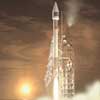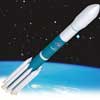|
Sunday:
May 14, 2000 | |
0226 GMT |
 |
Atlas 3 rocket to fly historic maiden voyage on Monday
American and Russian technology once poised to annihilate the enemy country will come together for a peaceful and historic marriage on Monday afternoon at Cape Canaveral when Lockheed Martin launches the first Atlas 3 rocket. Follow the countdown and launch in our Mission Status Center and live streaming video broadcast.
 FULL STORY FULL STORY
 MISSION STATUS CENTER MISSION STATUS CENTER
 INSIDE THE COMPLEX 36 BLOCKHOUSE INSIDE THE COMPLEX 36 BLOCKHOUSE
 |  |

|
 |
Atlantis astronauts return to Florida tonight
The seven international astronauts that will fly aboard space shuttle Atlantis' upcoming mission are due to arrive at Kennedy Space Center tonight. Countdown clocks begin ticking Monday for Thursday's scheduled sunrise liftoff. Follow the countdown in our Mission Status Center.
 MISSION STATUS CENTER MISSION STATUS CENTER
 STS-101 SPECIAL REPORT STS-101 SPECIAL REPORT
 |  |

|
 |
Long-lost asteroid found
Nearly 89 years after its original discovery, the long-lost asteroid (719) Albert has finally been reobserved. With this finding, it can safely be said that the current position is known of every one of the 14,788 asteroids in the numbered sequence that began with the discovery of (1) Ceres in 1801.
 FULL STORY FULL STORY
 |  |

|
 |
|
Saturday:
May 13, 2000 | |
0317 GMT |
 |
NASA debates options for Mars mission in 2003
In 2003, NASA may launch either a Mars scientific orbiter mission or a large scientific rover which will land using an airbag cocoon like that on the successful 1997 Mars Pathfinder mission.
 FULL STORY FULL STORY
 |  |

|
 |
Poor maintenance, checks led to satellite damage
An investigation board found the High Energy Solar Spectroscopic Imager (HESSI) spacecraft was damaged in pre-flight vibration tests because of a malfunction in test equipment at NASA's Jet Propulsion Laboratory.
 FULL STORY FULL STORY
 |  |

|
 |
Mir spacewalk called a success
The first commercially financed spacewalk was completed Friday, meeting the goals set for the multi-hour extravehicular activity (EVA) outside of the Mir space station.
 FULL STORY FULL STORY
 |  |

|
 |
|
Friday:
May 12, 2000 | |
0437 GMT |
 |
Chandra witnesses birth of supernova
Images made by NASA's Chandra X-ray Observatory show for the first time the full impact of the actual blast wave from Supernova 1987A. The observations are the first time that X-rays from a shock wave have been imaged at such an early stage of a supernova explosion.
 FULL STORY FULL STORY
 |  |

|
 |
Cosmic 'dark matter' mapped
Astrophysicists at Bell Labs have detected the long-sought large-scale distribution of an invisible form of matter, called "dark matter," that pervades the universe. This invisible matter constitutes more than 90 percent of the mass in the universe. Since it cannot be seen by telescopes, its nature and distribution have puzzled astronomers for decades, making the quest to understand it one of the biggest challenges of science.
 FULL STORY FULL STORY
 |  |

|
 |
Spacewalk to be performed at Mir space station today
MirCorp will mark another milestone in space history today when the first commercially financed spacewalk is performed from the Mir station. The two cosmonauts will carrying out a series of maintenance tasks and experimental work during the six-hour EVA.
 FULL STORY FULL STORY
 |  |

|
 |
DAILY BRIEFING Other stories making news today
|
 |
Trouble predicted for 2001 budgets of NSF and NASA -- The House and Senate appropriations committees met last week to divide the $600 billion pie for FY 2001, and at the end of process, the subcommittees funding NSF and NASA both came up short. The chairmen of the VA, HUD, and Independent Agencies appropriations subcommittees are now faced with essentially doing more with less, with the possible outcome being disappointing budgets for NSF and NASA.
|
 |
|
Thursday:
May 11, 2000 | |
0501 GMT |
 |
Delta rocket launches replacement GPS satellite
A fresh spacecraft was launched into orbit for the U.S. Air Force's Global Positioning System on Wednesday to fill a void created by the recent loss of the constellation's inaugural satellite.
 FULL STORY FULL STORY
 MISSION STATUS CENTER MISSION STATUS CENTER
 LAUNCH VIDEO (QuickTime file) LAUNCH VIDEO (QuickTime file)
 LAUNCH PHOTO GALLERY LAUNCH PHOTO GALLERY
 |  |

|
 |
Hubble telescope sees galactic silhouettes
A new image from NASA's Hubble Space Telescope shows the unique galaxy pair called NGC 3314. Through an extraordinary chance alignment, a face-on spiral galaxy lies precisely in front of another larger spiral. This line-up provides the rare chance to visualize dark material within the front galaxy, seen only because it is silhouetted against the object behind.
 FULL STORY FULL STORY
 |  |

|
 |
Looking into asteroid Eros' saddle wall
One of the most interesting features on Eros is the "saddle," an indentation in the asteroid's peanut-like shape. The low density of impact craters inside the saddle indicates that geologic processes had modified the region relatively late in Eros' history.
 FULL STORY FULL STORY
 |  |

|
 |
DAILY BRIEFING Other stories making news today
|
 |
NASA gearing up to launch Atlantis to ISS next week -- Flight controllers in Houston and Moscow are preparing for the next launch attempt of the Shuttle Atlantis to send six American astronauts and a Russian cosmonaut to the International Space Station (ISS).
|
 |
|
Wednesday:
May 10, 2000 | |
0424 GMT |
 |
Delta 2 launch of Air Force GPS satellite tonight
A Boeing Delta 2 rocket is once again poised for liftoff at Cape Canaveral to place a crucial military navigation satellite into space after two false starts last month. The launch is scheduled for tonight at 9:48 p.m. EDT. Follow the countdown and launch in our live Mission Status Center and streaming video broadcast.
 MISSION STATUS CENTER MISSION STATUS CENTER
 |  |

|
 |
Astronomers discover brown dwarf 'missing link'
Three brown dwarfs have been identified of a type never before observed, so filling in what has until now been an elusive 'missing link' in the range of properties of known brown dwarfs.
 FULL STORY FULL STORY
 |  |

|
 |
Team to provide backup communications satellites
A company called AssureSat plans to deploy two specially designed satellites in 2002 aboard Sea Launch rockets to offer the first in-orbit backup protection service for the geostationary communications services, allowing satellite operators to shift to the new craft in the case of failure.
 FULL STORY FULL STORY
 |  |

|
 |
DAILY BRIEFING Other stories making news today
|
 |
NASA names crew for future space station mission -- Veteran astronaut James D. Wetherbee (Capt., USN) will command the eighth Space Shuttle mission to visit the International Space Station on a flight in 2001 to rotate space station crews and continue space station assembly.
|
 |
|
Tuesday:
May 9, 2000 | |
0421 GMT |
 |
Titan 4 rocket soars to successful mission
The U.S. military launched a new spy satellite on Monday to guard the nation's security by providing advance warning against impending enemy missile attacks. A Titan 4B rocket lofted the Defense Support Program spacecraft from Cape Canaveral, Florida.
 FULL STORY FULL STORY
 MISSION STATUS CENTER MISSION STATUS CENTER
 LAUNCH VIDEO (QuickTime file) LAUNCH VIDEO (QuickTime file)
 |  |

|
 |
XMM-Newton telescope views a cluster of jewels
Since the end of commissioning, ESA's new X-ray space observatory has been viewing an average of one or more calibration target every day. One such target has been NGC 2516, a young open cluster in the southern hemisphere.
 FULL STORY FULL STORY
 |  |

|
 |
NEAR Shoemaker puts Eros into perspective
Though NEAR Shoemaker returns images that reveal a wealth of detail about the landforms on Eros' surface, appreciating the scale of these features can be a little difficult without roads, buildings, trees or other familiar landmarks.
 FULL STORY FULL STORY
 |  |

|
 |
DAILY BRIEFING Other stories making news today
|
 |
New GOES weather satellite almost in final orbit -- The third and final orbit raising maneuver is planned today for the newest U.S. weather satellite launched last week. The GOES-L spacecraft is slated to fire its liquid-fueled apogee kick engine for about eight minutes beginning at 4:02 p.m. EDT (2002 GMT).
|
 |
|
Monday:
May 8, 2000 | |
0233 GMT |
 |
Titan 4 launch today
The U.S. Air Force is counting down to today's planned liftoff of a Titan 4B rocket carrying a spy satellite capable of detecting missile launches and nuclear detonations. Follow the countdown and launch in our live Mission Status Center and streaming broadcast.
 MISSION STATUS CENTER MISSION STATUS CENTER
 LAUNCH PREVIEW STORY LAUNCH PREVIEW STORY
 |  |

|
 |
Dust grains older than comets
Comets, the icy wanderers that occasionally grace the inner Solar System, have long been considered the oldest and most pristine components of the primordial material out of which the planets and their cortege of satellites were spawned. Now, new research has cast fresh doubts on this long-cherished impression.
 FULL STORY FULL STORY
 |  |

|
 |
DAILY BRIEFING Other stories making news today
|
 |
Stellar Neonates -- Loners or Escapees? -- Over the last few decades, astronomers have refined a cosy picture of star-formation involving the gravitational collapse of a large molecular cloud complex, which subsequently fragments into several sub-clouds, each developing into new stellar systems in only a few million years.
|
 |
 |

